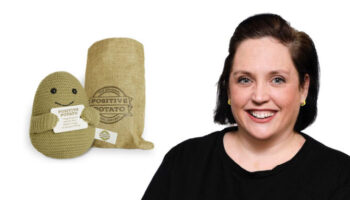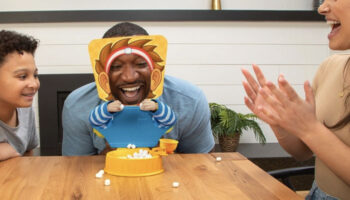Graeme Fraser-Bell on following Accentuate with his new word game of the elements, FReNeTiC

Almost four years since launching his first game, the guess-the-accent party game favourite Accentuate, Dr. Graeme Fraser-Bell has debuted his follow-up in the form of FReNeTiC, a frenzied word game of the elements.
Featuring a game board made up of the Periodic Table of the Elements, FReNeTiC sees players write down as many words as possible within 45 seconds from Element symbol tiles placed on the board (and before you ask, Graeme tells us there are more than 10,000 words that can be created from the Element symbols of the Periodic Table).
We caught up with Fraser-Bell to find out more about where the idea for FReNeTiC came from and what lessons he learnt from the design process behind Accentuate that informed the development of his latest game.

Can you talk us through the concept of FReNeTiC?
FReNeTiC is the frenzied word game of the elements. The game board is a customised version of the Periodic Table of the Elements. Amazingly there are more than 10,000 words that can be created from the Element symbols of the Periodic Table.
Historically, it was Dimitri Mendeleev who created the Periodic Table in 1869 with the British chemist Henry Moseley creating the concept of atomic numbers as the organising principle in 1913. FReNeTiC only uses 96 of the 118 Elements as eight of the Element symbols can not be used to create any English language words and the other 14 symbols can only be used to create less than 10 words.
It’s a challenging and addictive word search game, with all players engaged all the time. Players must write down as many words as possible within 45 seconds, from Element symbol tiles placed on the board. The novel scoring system uses the Atomic Numbers of the Element symbols used to score the word (e.g. Ba Na Na = Banana = 56 + 11 + 11 = 78 points.
Ten of the Element symbol spaces on the board are coloured red and were chosen through statistical frequency analysis, which showed they could only be used to create fewer than 30 words. Words formed from these symbol tiles allow double word scores.
13 of the Element symbol spaces have bold Green borders and are actually elements that can be created from the symbol tiles (e.g. Si Lv Er). Players creating one of these words can win FReNeTiC blank tiles for use as ‘Joker’ tiles.
Interestingly, unlike Scrabble, there are no words in FReNeTiC that can be created starting with J, Q or Z. The most frequently used element symbols to create words in FReNeTiC are: S, I, N, C, O, P, Es, H, Er, U, B and In.
The game combines, skill, luck and strategy at a frenzied pace and challenges players aged eight and above to form words from letters scattered around a board with capital letters that may appear in the middle of a word. The winner is the first to score 1,000 points.
To date, we believe the highest scoring word is W I N Db U R N = 417 x 2 (as Db is a double word score) = 834!
Where did the idea for the game come from?
Myself, my sister Fiona and my wife Daphne had been developing and screening a bunch of ideas for our much needed second game, following the success of Accentuate, but were struggling to identify that ‘tingle’ moment.
Whilst on holiday in October last year, I was reading about Alfred Mosher Butts, the creator of Scrabble. In his research he identified three generic forms of games – number games, move games and word games.
From Butts’ experiences, I became determined to create a novel word game but couldn’t envisage the theme. Then it struck me, I always say to people, “everyone has a game in them” and those games are usually based on personal experiences in life. I also remembered the mantra “you take your school life with you all your life”.
But how did that help? I failed my 11+, wasn’t smart or good at any particular subject at school and only later developed a passion for chemistry and managed to get a Bachelors and a Doctorate in Chemistry from Oxford. That was it! The Periodic Table! What if the 118 Element Symbols could form the basis for a word search board game?
Unlike Butts, who used statistical frequency analysis by reading the front page of the New York Times every day and recording the frequency each letter appeared to create the scoring system for Scrabble, I leveraged the work of Henry Moseley who created the concept of Atomic Numbers and chose that as the scoring metric within FReNeTiC.
The next day, from my sun lounger, I had drafted out a preliminary game-play, a selection of names and instructed our IP partners to draft out copyright, trademark and design protection for the EU28, USA and Canada.
Six months later and it’s on the shelves at all 51 John Lewis stores.

Was there anything you learned from the design process behind your first game, Accentuate, that informed the development of FReNeTiC ?
Absolutely! You ‘grab’ with the lid and ‘sell’ with the base, a lesson that we are correcting with Accentuate’s re-design in AW18.
We used the same design partners as for Accentuate, but this time, up-scaled the box, used glossy, bold, bright, primary colours, not a hint of a Periodic Table on the lid and an uncluttered, minimalistic and predominantly visual explanation of the game on the base. It’s designed as much as possible for international scaleability, ease of international adoption and expansion.
Another thing we’ve learnt is to throw ego and ownership out the window. We worked up a prototype, sought feedback from our distributors, customers, PR partners and industry insiders and most importantly submitted the game to rigorous and independent playtesting.
It was slammed in many aspects but by stripping away our emotional ownership and ego, we were able to accept the recommendations and incorporated virtually all of them into a far more robust and compelling game, something we wished we had done from the get-go with Accentuate.
When we thought we had produced the ideal design, gameplay, rules and component mix, we then threw it back into the lion’s den and had the whole thing ripped apart again – this time by the genius Deej Johnson – to ensure not one single word was superfluous and that the reading complexity index was as close to zero as possible.
Detailed design analysis also revealed that we needed to customise the design of the Element Symbols in the FReNeTiC board. Un-like standard Periodic Tables, the letter ‘I’ was changed in some element symbol spaces and tiles to a fully capitalised I so the letter is ‘Serif-ed’ to make it easier to distinguish between I and L during play.
You always learn more from your mistakes than your successes and the same was true with FReNeTiC – a common but little reported issue is never be the final sign-off for design or production on your own creation!
How do you stay creative?
Read! From how the mind works (Daniel Kahneman), how products become contagious (Jonah Berger) to how to perceive events differently (Malcolm Gladwell).
Also, by working ‘at the coalface’. We learn so much from being ‘in-situ’ with our customer base, performing demonstration days around the country, noting feedback and analysing consumer behaviours and responses.
What for you makes a great game?
Games where the elements of skill, luck and strategy are balanced, but in an elegantly simplistic form. A game in which all players are engaged all the time and which at the end creates an addictive response – “lets play again”.
Quality components that combine in innovative ways to form key or winning structures – simple is elegant is beautiful!
Iconic games that fit my criteria for a great game would be Scrabble, Santorini, Cranium and Dobble.
For more on FReNeTiC, head to www.freneticgame.com or you can reach Graeme at [email protected].






















